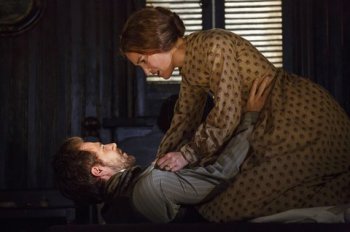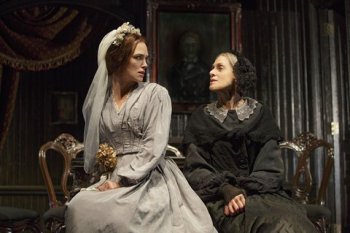Thérèse Raquin
Newly commissioned Roundabout adaptation of Emile Zola novel of passion and adultery with Keira Knightley’s Broadway debut is literal and passionless.
[avatar user=”Victor Gluck” size=”96″ align=”left” ] Victor Gluck, Editor-in-Chief[/avatar] The 1868 novel, Thérèse Raquin, has become the book with which French author Émile Zola has become most identified for Americans. It has been popularized with movies, plays, television adaptations, and operas. In recent memory, it has appeared Off Broadway at the Classic Stage Company with Elizabeth Marvel in a version by Neal Bell, a Broadway musical with a score by Harry Connick. Jr., an opera by Tobias Picker, a BBC Masterpiece Theater series with Kate Nelligan and Brian Cox, a movie retitled In Secret with Elizabeth Olson and Jessica Lange, and the classic 1953 Marcel Carné French film with Simone Signoret and Raf Vallone available on DVD. In its own time, Thérèse Raquin even appeared as a play on the Paris stage adapted by Zola from his own novel.
Roundabout Theatre Company has commissioned yet another new stage adaptation from British playwright Helen Edmondson, whose previous plays also include stage versions of Tolstoy’s Anna Karenina and George Eliot’s The Mill on the Floss. In the title role, Keira Knightley who has been associated with period drama in her distinguished film career (Atonement, Pride and Prejudice, Anna Karenina, and, of course, the Pirates of the Caribbean movies) has chosen to make her Broadway debut. She is supported by Tony Award-winner Gabriel Ebert (Matilda), British actor Matt Ryan, and two time Tony Award-winning actress Judith Light (Lombardi, Other Desert Cities, The Assembled Parties.) Unfortunately, director Evan Cabnet has chosen to stage this most French of tales in a bloodless, refined English style which doesn’t serve the material well.
While Edmundson’s adaptation is extremely faithful to the original Zola novel, that is part of the problem. In doing so, the new version requires a great many unnecessary set and scene changes which makes it much more like a television or film version than stageworthy. When we first meet the orphaned Thérèse, she is a silent, passive young woman who has grown up in the village home of her possessive aunt Madame Raquin and her weak, sickly cousin Camille. When she turns of age, Mme. Raquin engineers a loveless marriage between Thérèse and Camille. Soon after, Camille decides for monetary and career reasons to move to Paris. There he gets a job at the Orléans Railway Company and the three live above a haberdashery which the two women run.
One day, Camille brings home Laurent, a fellow employee, who he knew back in the village as a child. The handsome, charming, eager-to-please Laurent quickly ingratiates himself with Mme. Raquin and is asked to drop in to dinner as often as he likes. Offering to paint Camille’s portrait, the amoral Laurent finds himself alone with Thérèse and seduces the unfulfilled, willing woman. They begin a passionate affair which comes to an abrupt end when he can no longer take afternoons off from work. Now smitten with each other, they discuss getting rid of Camille in such a way that they won’t be caught. However, when they do, they discover they had not counted on the guilt and retribution which will be their undoing.
Cabnet has directed this tale of passion, adultery, murder and retribution as though it were a Masterpiece Theater tea party drama which sucks the life out of the story. As Thérèse, Knightley, who is required to be mostly silent and passive during Act I, gives an internalized performance so that very little is visible to the audience. She is excellent as the repressed, down-trodden woman before she meets Laurent, but does not reveal enough passion after they begin their affair to justify the storyline. Ryan is charming as Laurent but misses the lustiness and sensuality inherent in this opportunistic seducer. As their animal passion is never completely enacted, the play seems more like a shorthand for the story than a dramatization.
Light, known for waspish characters, underplays her role as Madame Raquin. She successfully delineates the woman’s passive-aggressive possessiveness and her self-righteousness but fails to make her into the monstrous mother that she is. As the sickly Camille, Gabriel Ebert attempts to make him comic with little result. He captures Camille’s immaturity and makes him a case of stunted development but he misses the nagging selfishness that would make one want to get rid of him. Jeff Still is amusingly pompous as Monsieur Grivet, one of the visitors at the weekly game of dominoes, but Daniel Patrick Kelly as retired Superintendent Michaud gives a one-dimensional performance. On the other hand, as his unmarried daughter Suzanne, Mary Wiseman travels a complete arc even though she is relegated to a minor role in the story.

Gabriel Ebert, Matt Ryan and Keira Knightley in a scene from “Thérèse Raquin” (Photo credit: Joan Marcus)
Beowulf Boritt’s sets are impressive, the oppressive Paris apartments with their detail, the riverbank scenes with their impressionist mood. However, as the sets are continually lifted into the air for the many scene changes, his designs become tedious and distracting. A great deal of effort has been expended to create a real river on stage, but this set is hardly used. Jane Greenwood’s period costumes have the right feel but putting Thérèse in the same dress throughout Act One seems like overdoing it. The atmospheric lighting by Keith Parham is used as an additional character as is the effective and scary sound design by Josh Schmidt.
Zola, given credit for inventing Naturalism in fiction, wrote Thérèse Raquin as a clinical study of the effects of an animal passion. If that passion isn’t made palpable, then the story just seems a grim account of life among the working classes. The Roundabout Theatre Company production of Helen Edmundson’s new adaptation of the Zola novel feels literal but perfunctory. Film star Keira Knightley shows great stage presence but seems miscast in this role which swings from passivity to passion and back again.
Thérèse Raquin (through January 3, 2015)
Roundabout Theatre Company
Studio 54, 254 W. 54th Street, in Manhattan
For tickets, call 212-719-1300 or visit http://www.roundabouttheatre.org
Running time: two hours and 30 minutes including one intermission








Leave a comment